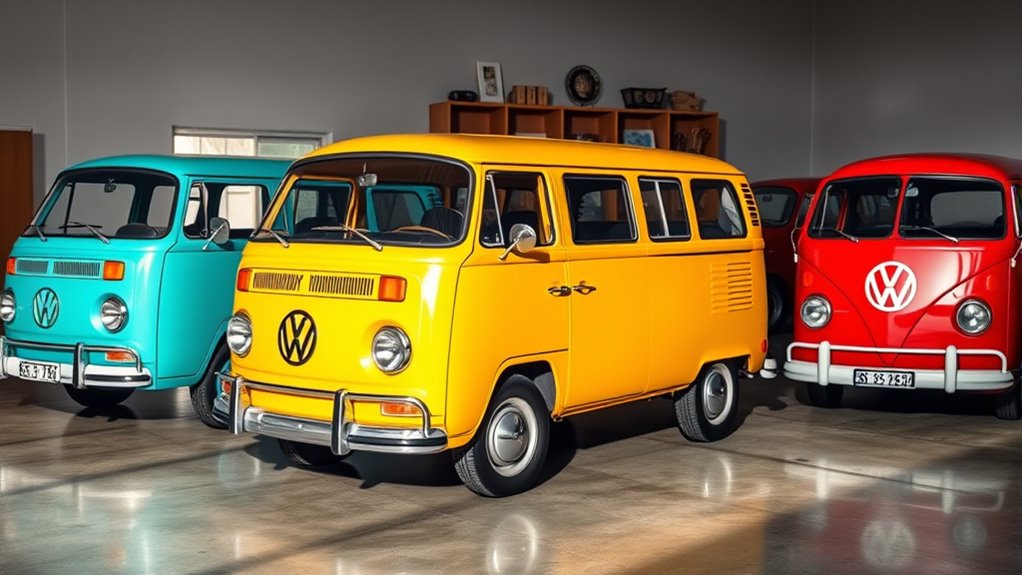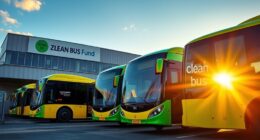To accurately value vintage VW buses, focus on their originality, condition, and rarity. Well-preserved or expertly restored models with matching numbers and authentic parts fetch higher prices, especially sought-after variants like Westfalia campers. Market trends fluctuate based on demand for classic vehicles and nostalgic appeal. Keep an eye on recent auction results and listings to gauge current values. If you want to uncover detailed tips for evaluating and maximizing your VW bus’s worth, continue exploring.
Key Takeaways
- Authenticity, originality, and condition are primary factors influencing vintage VW bus valuation.
- Rare models like Westfalia campers or limited editions typically command higher prices.
- Well-documented restorations with matching numbers and original parts increase market value.
- Market demand and recent auction results significantly impact current pricing trends.
- Proper restoration preserving originality and using authentic materials enhances vehicle worth.

Vintage VW buses remain highly sought after by collectors and enthusiasts alike, thanks to their iconic design and nostalgic appeal. If you’re looking to evaluate their value or plan a restoration, understanding current market trends and applying effective restoration tips can make a significant difference. The vintage VW bus market has experienced notable fluctuations over recent years, driven by increasing demand for classic vehicles that evoke a sense of carefree road trips and vintage charm. Recognizing these market trends is essential because they influence pricing—rare models, well-maintained examples, and those with authentic parts tend to command higher prices. As a collector, you should keep an eye on auction results, online listings, and vintage car shows to gauge how the market is moving and what specific features or models fetch premium prices.
When it comes to restoring a vintage VW bus, your goal should be to preserve authenticity while enhancing its overall condition. Restoration tips start with a thorough inspection of the vehicle’s frame, engine, and body panels. Address rust issues immediately, as corrosion can dramatically decrease value and compromise safety. Sanding, patching, and applying rust inhibitors are crucial steps to ensure longevity. Original paint colors and badges add to the authenticity, so whenever possible, aim to preserve or accurately reproduce the factory finishes. Inside, focus on maintaining or restoring the original dashboard, seats, and flooring. Replacing worn-out upholstery with period-correct materials boosts appeal without sacrificing originality. For mechanical components, sourcing authentic parts or high-quality reproductions is vital—this not only improves performance but also maintains the vehicle’s collectible value. Additionally, keeping up with technological advancements, such as modern restoration tools and materials, can streamline your process and enhance the final outcome.
Pricing your vintage VW bus accurately depends on its originality, condition, and rarity. A well-restored model with matching numbers and authentic parts can fetch a premium, especially if it’s a sought-after variant like the Westfalia camper. Meanwhile, incomplete or heavily modified buses tend to be valued lower, though they can still be appealing for enthusiasts interested in customization or project builds. Keeping detailed records of restorations and repairs adds credibility, often translating into higher market value. As market trends continue to evolve, staying informed about collector preferences and investing in quality restoration work will help maximize your vintage VW bus’s worth. Whether you’re buying, selling, or restoring, understanding these key factors ensures you make informed decisions, aligning your efforts with current market dynamics.
Frequently Asked Questions
How Do Rare Color Schemes Affect a Bus’s Value?
Rare color schemes can considerably boost your bus’s value because they stand out and appeal to collectors. However, these colors often increase restoration challenges, especially during color restoration, since finding matching paint can be tough. If you preserve or restore a bus with a rare hue, it adds uniqueness and desirability, making it more attractive to buyers and potentially increasing its market worth.
What Are the Most Sought-After VW Bus Models Today?
You’ll find that the most sought-after VW bus models today are the Split-window (Type 2) and T2 Westfalia campers. To keep their value high, focus on restoration techniques that preserve authenticity, like original paint and parts. Regular maintenance tips, such as engine checks and rust prevention, help sustain their appeal. By maintaining these models well, you boost their desirability and guarantee they remain a prized collector’s item.
How Do Modifications Impact a Vintage VW Bus’s Worth?
Modifications can lower your vintage VW bus’s worth if they compromise restoration authenticity, especially if they’re heavy-handed or non-original. Buyers value genuine details and original parts, so aftermarket accessories that enhance authenticity might boost its appeal. However, custom mods that stray from factory standards often decrease value. Focus on maintaining originality, and consider subtle upgrades to preserve or even increase your bus’s market worth.
Are There Regional Market Differences in VW Bus Valuations?
Picture a vintage VW bus as a beacon shining differently across regions. You’ll find that regional demand influences valuations—some areas treasure these classics more, boosting prices. Market fluctuations also play a role, as local economic conditions and collector interest ebb and flow. You should consider these regional nuances because they can markedly impact your bus’s worth, making it essential to research local markets before selling or buying.
What Upcoming Trends Could Influence VW Bus Prices?
Upcoming trends like electric conversions could boost VW bus prices, as enthusiasts seek modern upgrades that preserve vintage appeal. The nostalgia factor remains strong, attracting buyers who want classic style with eco-friendly features. You might see increased demand as more owners convert their buses to electric, making them more desirable. Staying aware of these trends helps you anticipate market shifts and spot valuable investments in vintage VW buses.
Conclusion
You might think vintage VW buses hold steady in value, but the market proves otherwise. Their worth shifts with rarity, condition, and nostalgia’s pull, making each one unique. If you believe classic buses are only worth a look for collectors, you’re missing out on a dynamic, evolving scene. By understanding these factors, you can better gauge their true value and perhaps even find that perfect vintage VW to cherish—because in this market, history and passion drive the price.








